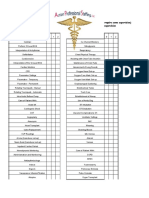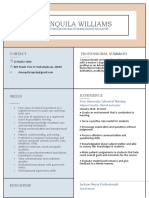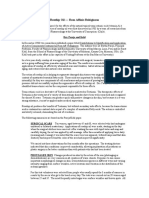Baystate Med CTR Rapid Response Team Recordwith SBAR
Baystate Med CTR Rapid Response Team Recordwith SBAR
Uploaded by
Danishyana DhiwaneoCopyright:
Available Formats
Baystate Med CTR Rapid Response Team Recordwith SBAR
Baystate Med CTR Rapid Response Team Recordwith SBAR
Uploaded by
Danishyana DhiwaneoOriginal Description:
Original Title
Copyright
Available Formats
Share this document
Did you find this document useful?
Is this content inappropriate?
Copyright:
Available Formats
Baystate Med CTR Rapid Response Team Recordwith SBAR
Baystate Med CTR Rapid Response Team Recordwith SBAR
Uploaded by
Danishyana DhiwaneoCopyright:
Available Formats
Patient Identification Information/Sticker
(12/4/08)
RAPID RESPONSE TEAM
RECORD
FAMILY ACTIVATED CALL:
Date:_______ Time RRT Called: _______ Time RRT Arrived: _______
CALLER TO COMPLETE
Person (Name) placing call: ________________________________
Responders:
RN
RT
IV RN
MD/Resident
Covering Physician: __________________ MD notified Yes/No: ___________ Response Yes/No: ___________ Arrival time:___________
SITUATION
Concern that something is wrong
BACKGROUND / HISTORY
Other
Failure to Respond to Treatment
Other Acute Decline in Patient
Condition
Neurological
Acute Change in Level of
Consciousness
Difficulty Speaking
Agitation, Delirium or Seizures
Early Sepsis
Infection-documented or suspected
On anti infective therapy
Increased/decreased WBCs count
( > 12,000 or < 4,000)
Respiratory
Respiratory Distress (rate <8 or >28
BPM)
Threatened Airway
Change in Respiratory Rate
SaO2 less than 90% on O2
(<90% despite supplement O2)
Cardiovascular
Change in Systolic BP (<90 mmHg)
Change in HR (<40 or >130 BPM)
Diabetes
Renal
Dialysis
CHF
Stroke
Surgery _________
Pneumonia
Other:
DNR/DNI
CMO
RRT NURSE ASSESSMENT ON ARRIVAL:
Initial vital signs: (2 or more consider early sepsis)
Temp:______ (>100.4 or <96.8)
HR:______ (>90 bpm)
LOC:________ Breath Sounds: _______________
RR:______ (>20) BP: _________ O2 Sat ________ FiO2: ________
Pain Level: ________ (0-10 Scale)
Blood Sugar: ____________
UNRESPONSIVE PATIENT:
TESTS/LABS:
Administer 50ml D50 (1 amp)
Time administered: __________
Repeat POC in 20 min: __________
AIRWAY/BREATHING:
Titrate FiO2 to maintain patients O2 saturation >92% (use any modality)
Time: ____________
Modality used: _________________
PORTABLE CXR_________
CQ: Pneumonia
(HX new/sudden onset respiratory
symptoms/distress
& no CXR obtained within last 24 hours)
CIRCULATION:
If no signs/symptoms of HF & SBP <80mm: Administer 500ml 0.9%
NS x 1
Time administered: ______________
N/A
12 lead ECG Time: ________
MEDICATIONS/ADDITIONAL INTERVENTIONS:
Check POC glucose If <60 mg/dl: If patient
awake:
administer 25ml D50 (1/2 amp)
Time administered: _____________
Repeat POC BG: ________________
ISTAT POC ABG, Lactate, & Electrolytes if not
previously done in the last 30-60
minutes
Time: _________
pH: _____________
Lactate:_____________
CO2 _____________
PO2 _____________
HCO3 ____________
ADDITIONAL VITAL SIGNS / TIME
Continue documentation of meds & vital signs on back of *WHITE FORM*
RRT NURSE FINAL ASSESSMENT:
#194 12-2008
Disposition:
No transfer
Intercare
ICU or CICU
Physician: ___________________________________________
RRT RN: _____________________________________________
Follow Up Visit: _________________________________
RRT DEPARTURE TIME:_____________
Progressed to Code
Made DNR/CMO Time of transfer: _______
RRT RT: ______________________________________________
Time of Visit: ________________________
RRT Call Debrief Conducted:
Family involved in debrief
Patient had subsequent Code Blue;
Yes
No
Yes
No
Patient expired;
Patient survived to discharge (Date) ____________________________
White Copy Send to Medical Record
Yellow Copy Return to Division of Healthcare Quality
ADDITIONAL DOCUMENTATION / TIME
Continue documentation on progress note if necessary
__________________________________________________________________________________________
__________________________________________________________________________________________
__________________________________________________________________________________________
__________________________________________________________________________________________
__________________________________________________________________________________________
__________________________________________________________________________________________
__________________________________________________________________________________________
SBAR report to physician about a critical situation
S
B
A
R
Situation
I am calling about <patient name and location>
The patients code status is <code status>
The problem I am calling about is ___________________________________.
I am afraid the patient is going to arrest.
I have assessed the patient personally:
Vital Signs are:
Blood Pressure _______/_______, Pulse ________, Respiration _______ &
Temperature _________
I am concerned about the:
Blood pressure because it is less than 90 or 30 mmHg below usual.
Pulse because it is
over 130 or
less than 40.
Respiration because it is
less than 8 or
over 24.
Background
The patients mental status is:
Alert and oriented to person, place and time.
Confused and
cooperative or
non-cooperative.
Agitated or combative.
Lethargic but conversant and able to swallow.
Stuporous and not talking clearly and possible not able to swallow.
Comatose. Eyes closed. Not responding to stimulation.
The skin is:
Warm and dry
Pale
Mottled
Diaphoretic
Extremities are cold
Extremities are warm
The patient
is not or
is on oxygen:
The patient has been on _______________(l/min) or (%) oxygen for _______________ minutes
(hours)
The oximeter is reading _______________%
The oximeter does not detect a good pulse and is giving erratic readings
Assessment:
This is what I think the problem is: <say what you think is the problem>
The problem seems to be
cardiac
infection
neurologic
respiratory
______________
I am not sure what the problem is but the patient is deteriorating
The patient seems to be unstable and may get worse, we need to do something
Recommendation:
I
suggest or
request that you <say what you would like to see done>
Transfer the patient to critical care
Come to see the patient at this time
Talk to the patient or family about code status
Ask the on-call family practice resident to see the patient now
Ask for a consult to see the patient now
Are any tests needed:
Do you need any tests like
CXR,
ABG,
EKG,
CBC or
BMP?
Others:
If a change in treatment is ordered then ask:
How often do you want vital signs?
How long do you expect this problem will last?
If patient does not get better when would you want us to call again?
You might also like
- Hospice Capital Program Design Standards: June 2017Document17 pagesHospice Capital Program Design Standards: June 2017Josh DyNo ratings yet
- Managing Linen at Apollo HospitalsDocument7 pagesManaging Linen at Apollo HospitalsSrijon Moitra0% (2)
- Arc Guideline 11 1 Introduction To and Principles of in Hospital Resuscitation Feb 2019Document22 pagesArc Guideline 11 1 Introduction To and Principles of in Hospital Resuscitation Feb 2019hernandez2812No ratings yet
- Respiratory Therapist Skills ChecklistDocument3 pagesRespiratory Therapist Skills Checklisthealth careNo ratings yet
- Career CNA PDFDocument2 pagesCareer CNA PDFdgina8800No ratings yet
- Certificate and Duties and ResponsibilitiesDocument2 pagesCertificate and Duties and ResponsibilitiesShiredan Rose BagarinaoNo ratings yet
- 2 EsiDocument23 pages2 EsizianaNo ratings yet
- Crowding Boarding and Patient Through PutDocument9 pagesCrowding Boarding and Patient Through PutMarwa El SayedNo ratings yet
- ITEEN 9 Progress Test6Document16 pagesITEEN 9 Progress Test6Marisa Montes100% (1)
- The COAT & Review Approach: How to recognise and manage unwell patientsFrom EverandThe COAT & Review Approach: How to recognise and manage unwell patientsRating: 5 out of 5 stars5/5 (1)
- Mews ScoreDocument13 pagesMews Score2009nicoleta100% (2)
- Stroke Clinical PathwayDocument1 pageStroke Clinical PathwayKanoknun PisitpatcaragulNo ratings yet
- Epworth Richmond - Agency Staff Orientation Booklet MAY 2016Document33 pagesEpworth Richmond - Agency Staff Orientation Booklet MAY 2016Anonymous BaD9jQNo ratings yet
- Ambulance TransferDocument6 pagesAmbulance TransferEsamNo ratings yet
- Critical Care Skills Check ListDocument3 pagesCritical Care Skills Check Listhemarani60605582100% (1)
- 1008 1400 ACLS - StudyGuide Print PDFDocument54 pages1008 1400 ACLS - StudyGuide Print PDFWaqar HassanNo ratings yet
- The Critical-Care Pain Observation Tool (CPOT) : Indicator Score DescriptionDocument6 pagesThe Critical-Care Pain Observation Tool (CPOT) : Indicator Score DescriptioncignalNo ratings yet
- 2012 Cleveland Clinic Regional Hospitals EMS ProtocolDocument330 pages2012 Cleveland Clinic Regional Hospitals EMS ProtocolMarian Ioan-LucianNo ratings yet
- DPN Icu PDFDocument1 pageDPN Icu PDFharoonNo ratings yet
- Acute Respiratory Distress: Section I: Scenario DemographicsDocument6 pagesAcute Respiratory Distress: Section I: Scenario DemographicsharasthaNo ratings yet
- ACLS Online Training Material: Unit One: General ConceptsDocument34 pagesACLS Online Training Material: Unit One: General ConceptsJohn JenjinsNo ratings yet
- Sdms Id: P2010/0322-001 Ref No Wacsclinproc1.11 Title: Intravenous Iron InfusionDocument5 pagesSdms Id: P2010/0322-001 Ref No Wacsclinproc1.11 Title: Intravenous Iron InfusionYwagar Ywagar100% (1)
- Nursing AssementDocument14 pagesNursing AssementSumathi AkshayaNo ratings yet
- Nurse Educator Resume 2020Document4 pagesNurse Educator Resume 2020api-531213693100% (1)
- TraumaDocument12 pagesTraumagibreilNo ratings yet
- Rapid Response TeamDocument4 pagesRapid Response TeamMichael SilvaNo ratings yet
- Clinical Handover Ian ScottDocument26 pagesClinical Handover Ian ScottYwagar Ywagar100% (1)
- Shockable and Unshockable RhytmDocument39 pagesShockable and Unshockable Rhytmariahenkus100% (1)
- IV TherapyDocument65 pagesIV TherapySarah Uy CaronanNo ratings yet
- Lesson PlanDocument10 pagesLesson PlanalishaNo ratings yet
- Emergency Department Intubation ChecklisTDocument2 pagesEmergency Department Intubation ChecklisTStacey Woods100% (1)
- Lesson 1 Introduction To Emergency CareDocument15 pagesLesson 1 Introduction To Emergency CareDominica FuentesNo ratings yet
- BradycardiaDocument8 pagesBradycardialetonierNo ratings yet
- Admitting A Patient .: Prepared by Ayugi Winnyfred Patience Bsc. Midwifery StudentDocument10 pagesAdmitting A Patient .: Prepared by Ayugi Winnyfred Patience Bsc. Midwifery StudentAYO NELSONNo ratings yet
- EMS - Chapter 1 (Intro To EMT)Document2 pagesEMS - Chapter 1 (Intro To EMT)Daniel Kipnis0% (1)
- Patient AssessmentDocument3 pagesPatient AssessmentYemaya84100% (1)
- 2018-04-09 Pediatric Emergency Nursing Assessment Record FormDocument2 pages2018-04-09 Pediatric Emergency Nursing Assessment Record FormHengkyNo ratings yet
- Pre-Op Assessment: Dr. Ayesha Ehsan House Surgeon S-IIDocument25 pagesPre-Op Assessment: Dr. Ayesha Ehsan House Surgeon S-IIFatima MNo ratings yet
- Cerner Ehr GuideDocument17 pagesCerner Ehr GuideAhmad AhmadNo ratings yet
- Scoop and Run To Stay and PlayDocument17 pagesScoop and Run To Stay and PlayTiban Parthiban100% (1)
- Post Fall Huddle FormDocument2 pagesPost Fall Huddle FormRuby JostNo ratings yet
- Face Sheet, Patient Assessment & Reassessment, History, Physical Examination, Admission/Discharge RecordDocument7 pagesFace Sheet, Patient Assessment & Reassessment, History, Physical Examination, Admission/Discharge RecordRonald Allan Valle SantosNo ratings yet
- NC State University Veterinary Teaching Hospital Medical Records Documentation GuideDocument14 pagesNC State University Veterinary Teaching Hospital Medical Records Documentation GuideTriwanti TiagaNo ratings yet
- Canadian Triage PDFDocument3 pagesCanadian Triage PDFJany UllauriNo ratings yet
- Gpas 2015 10 PaediatricsDocument14 pagesGpas 2015 10 PaediatricsZack TaylorNo ratings yet
- Welcome To All: Nursing StaffDocument67 pagesWelcome To All: Nursing StaffMukesh Choudhary JatNo ratings yet
- Assessment of Icu PatientDocument33 pagesAssessment of Icu PatientJRRMMC Nursing Division TWG100% (1)
- NRP 8th Edition Prep Packet 2022 5Document21 pagesNRP 8th Edition Prep Packet 2022 5kassimfaizyNo ratings yet
- CvicuDocument2 pagesCvicuapi-401768894No ratings yet
- M E W S: Mews (Odified Arly Arning Ystem) 3 2 1 0 1 2 3 ScoreDocument1 pageM E W S: Mews (Odified Arly Arning Ystem) 3 2 1 0 1 2 3 ScoreMimi SunaryantiNo ratings yet
- ICU Assessment FormDocument6 pagesICU Assessment Formroro.8787.roroNo ratings yet
- Basic Trauma Life SupportDocument43 pagesBasic Trauma Life SupportperawatNo ratings yet
- Legal Issues Emergency Medicine (Final)Document97 pagesLegal Issues Emergency Medicine (Final)GerardChanNo ratings yet
- Assessor Guide: Certification of Emergency Department in HospitalDocument11 pagesAssessor Guide: Certification of Emergency Department in Hospitalclab yuNo ratings yet
- Acls AnpDocument20 pagesAcls AnpNirupama KsNo ratings yet
- Trauma Nursing Core Course: Preparation PacketDocument13 pagesTrauma Nursing Core Course: Preparation PacketJimmy NaglesNo ratings yet
- Chest Pain: Jean J. Chatham, MDDocument40 pagesChest Pain: Jean J. Chatham, MDYermia RashaquatNo ratings yet
- Step Down RN or Progressive Care Skills ChecklistDocument4 pagesStep Down RN or Progressive Care Skills Checklisthealth careNo ratings yet
- Short Term Training Curriculum Handbook - EMT-B - 1 June 2017 - 1Document48 pagesShort Term Training Curriculum Handbook - EMT-B - 1 June 2017 - 1navneetNo ratings yet
- Emergency and Disaster NursingDocument19 pagesEmergency and Disaster NursingRb CaractaNo ratings yet
- Patient Safety Organization A Complete Guide - 2020 EditionFrom EverandPatient Safety Organization A Complete Guide - 2020 EditionNo ratings yet
- NURSING CARE OF ADULTS II: Passbooks Study GuideFrom EverandNURSING CARE OF ADULTS II: Passbooks Study GuideNo ratings yet
- In-Patient Claim Form: (To Be Filled by Claimant Employee)Document2 pagesIn-Patient Claim Form: (To Be Filled by Claimant Employee)Khan LalaNo ratings yet
- Periprosthetic FRACTURESDocument162 pagesPeriprosthetic FRACTURESVidakpaz Vidacapaz100% (2)
- Gani Leio N. Caalim: Skills / Interests / QualificationsDocument3 pagesGani Leio N. Caalim: Skills / Interests / QualificationsNenita CaalimNo ratings yet
- The Real ZumavilleDocument1 pageThe Real ZumavilleCityPressNo ratings yet
- Patricia Benner PP Nurs 324Document31 pagesPatricia Benner PP Nurs 324api-251662522No ratings yet
- Memorandum of Agreement: Know All Men by These PresentsDocument4 pagesMemorandum of Agreement: Know All Men by These PresentsReslyn YanocNo ratings yet
- Alaga Ka: para Sa Maayos Na BuhayDocument22 pagesAlaga Ka: para Sa Maayos Na BuhayNooneNo ratings yet
- Drug StudyDocument5 pagesDrug StudyKC IgnacioNo ratings yet
- Vitamin K TOFDocument5 pagesVitamin K TOFNanank Akhiruddin SyamsaNo ratings yet
- Empanelled Hospital List - Maharashtra: SR No Hospital Location CityDocument72 pagesEmpanelled Hospital List - Maharashtra: SR No Hospital Location CityNishant ThakkarNo ratings yet
- Property DealsDocument17 pagesProperty DealsRachel Torres100% (1)
- Case PreDocument45 pagesCase PreElla Mapa Supnet100% (1)
- Hospital Directories of The PhilippinesDocument12 pagesHospital Directories of The PhilippinesAirwind VillarinNo ratings yet
- Capstone Research PaperDocument22 pagesCapstone Research Paperapi-251333389No ratings yet
- CASES (Long Form)Document7 pagesCASES (Long Form)KiieEemNo ratings yet
- Map ZeusDocument3 pagesMap ZeusKate ConanNo ratings yet
- Basic Physician Training (BPT Year 1 and 2) at The Royal Hobart Hospital: Information Sheet 2022Document1 pageBasic Physician Training (BPT Year 1 and 2) at The Royal Hobart Hospital: Information Sheet 2022nevermore11No ratings yet
- Reaction Paper On Philippine Public Health SystemDocument1 pageReaction Paper On Philippine Public Health SystemChidori BaeNo ratings yet
- MINI International Neuropsychiatric Schedule: Clinical Utility and Patient AcceptanceDocument4 pagesMINI International Neuropsychiatric Schedule: Clinical Utility and Patient AcceptanceRafael MartinsNo ratings yet
- Fdarcharting 120314214902 Phpapp02Document5 pagesFdarcharting 120314214902 Phpapp02John Louie SolitarioNo ratings yet
- En W5 V1.0 BrochureDocument6 pagesEn W5 V1.0 BrochurercortesflowmedNo ratings yet
- Rosehip OilDocument2 pagesRosehip OilTy VoNo ratings yet
- Medical Negligence and MalpracticeDocument18 pagesMedical Negligence and MalpracticeJT Gal100% (3)
- Provoking "Eureka" Moments For Effective Infection Control StrategiesDocument3 pagesProvoking "Eureka" Moments For Effective Infection Control StrategiesClaude SUPERNo ratings yet
- RDBMS Lab GuideDocument33 pagesRDBMS Lab GuideRamasamy GoNo ratings yet
- Planning and Designing An Isolation Facility in Hospitals Need of The Hour PDFDocument9 pagesPlanning and Designing An Isolation Facility in Hospitals Need of The Hour PDFdzakyzahidNo ratings yet
- Epinephrine For Cardiac Arrest.7Document7 pagesEpinephrine For Cardiac Arrest.7Nurul AflahNo ratings yet

























































































